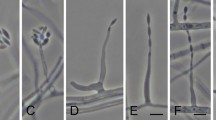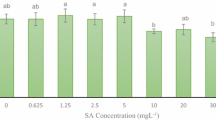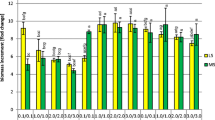Abstract
Three different Fusarium culmorum strains having a pathogenic, a deleterious (deleterious rhizosphere microorganism), or a promoting (plant growth promoting fungus) effect on plant growth were studied for their ability to synthesize in vitro the phytohormones indoleacetic acid (IAA), gibberellic acid (GA), and ethylene. All the phytohormones tested were synthesized in cultures supplemented with wide concentration ranges of glucose and tryptophan or methionine (precursors of phytohormone synthesis). The amounts of these secondary metabolites synthesized by the particular strains were found to be significantly different. The non-pathogenic PGPF strain (DEMFc2) synthesized the highest amounts of IAA and GA, a fact that could be responsible for the growth-promoting properties of this strain. A pathogenic strain synthesized the highest amount of ethylene, which could be responsible for the negative effect of this strain on plant growth. F. culmorum isolates with a high capacity for IAA synthesis also have a high capacity for GA synthesis and irrespective of the growth conditions, a high positive correlation (R > 0.9) between the concentrations of synthesized IAA and GA in F. culmorum cultures was found. It is worth mentioning that the optimal conditions for the growth of F. culmorum isolates and the synthesis of the individual phytohormones differed from one another. The optimal growth conditions were 1.0% of glucose and 9.9 mM of methionine or 6.0 mM of tryptophan. The optimal conditions for ethylene synthesis were 0.5% of glucose and 6.6 mM of methionine, whereas 1.0% of glucose and 9.0 mM of tryptophan were optimal for IAA and GA synthesis.
Similar content being viewed by others
Abbreviations
- CFU:
-
colony forming units
- DRMO:
-
deleterious rhizosphere microorganism
- GA:
-
gibberellic acid
- IAA:
-
indoleacetic acid
- LSD:
-
least significant difference
- PGPF:
-
plant growth promoting fungus
References
Adams D.O. & Yang S.F. 1979. Ethylene biosynthesis: identification of 1-aminocyclopropane-l-carboxylic acid as an intermediate in the conversion of methionine to ethylene. Proc. Natl. Acad. Sci. USA 76: 170–174.
Ahmad F., Ahmad I. & Khan M.S. 2008. Screening of free-living rhizospheric bacteria for their multiple plant growth promoting activities. Microbiol. Res. 163: 173–181.
Akhtar M.J., Arshad M., Khalid A. & Mahmood M.H. 2005. Substrate-dependent biosythesis of ethylene by rhizosphere soil fungi and its influence on etiolated pea seedlings. Pedobiologia 49: 211–219.
Alef K. & Nannipieri P. 2005. Methods in Applied Soil Microbiology and Biochemistry. Academic Press, London, San Diego, 576 pp.
Armitage P. & Berry G. 1987. Statistical Methods in Medical Research. Blackwell Publications, Oxford, 361 pp.
Arshad M. & Frankenberger Jr W.T. 1989. Biosynthesis of ethylene by Acremonium falciforme. Soil Biol. Biochem. 21: 633–638.
Bayram O. & Braus G.H. 2012. Coordination of secondary metabolism and development in fungi: the velvet family of regulatory proteins. FEMS Microbiol. Rev. 36: 1–24.
Betina V. 1995. Differentiation and secondary metabolism in some prokaryotes and fungi. Folia Microbiol. 40: 51–67.
Bilkay I.S., Karakao S. & Akson N. 2010. Indole-3-acetic acid and gibberellic acid production in Aspergillus niger. Turk. J. Biol. 34: 313–318.
Billington D.C., Golding B.T. & Primrose S.B. 1979. Biosynthesis of ethylene from methionine. Isolation of the putative intermediate 4-methylthio-2-oxobutanoate from culture fluids of bacteria and fungi. Biochem. J. 182: 827–836.
Brandl M.T., Lindow S.E. 1998. Contribution of indole-3-acetic acid production to the epiphytic fitness of Erwinia herbicola. Appl. Environ. Microbiol. 64: 3256–3263.
Brückner B. 1992. Regulation of gibberellin formation by the fungus Gibberella fujikuroi, pp. 129–143. In: Chadwick D.J. & Whelan J. (eds) Secondary Metabolites: Their Function and Evolution. Ciba Foundation Symposium, vol. 171. Wiley, Chichester.
Brückner B., Blechschmidt D. & Recknagel R.D. 1991. Optimalization of nutrient medium for biosynthesis of gibberellic acid. J. Basic Microb. 31: 243–250.
Chagué V., Danit L.V., Siewers V., Schulze-Gronover C., Tudzynski P., Tudzynski B. & Sharon A. 2006. Ethylene sensing and gene activation in Botrytis cinerea: a missing link in ethylene regulation of fungus-plant interactions? Mol. Plant Microbe Interact. 19: 33–42.
Chagué V., Elad Y., Barakat R., Tudzynski P. & Sharon A. 2002. Ethylene biosynthesis in Botrytis cinerea. FEMS Microbiol. Ecol. 40: 143–149.
Cihangir N., Aksöz N. & Bozcuk S. 1996. The interaction of microorganismal plant growth regulators. Turk. J. Biol. 20: 135–142.
Cristescu S.M., De Martinis D., Hekkaert S.L., Parker D.H. & Harren F.J.M. 2002. Ethylene production by Botrytis cinerea in vitro and in tomato. Appl. Environ. Microbiol. 68: 5342–5350.
Daundasekera M., Joyce D., Aked J. & Adikaram N. 2003. Ethylene production by Colletotrichum musae in vitro. Physiol. Mol. Plant Pathol. 62: 21–28.
Daundasekera W.A.M., Joyce D.C, Adikaram N.K.B. & Terry L.A. 2008. Pathogen-produced ethylene and the Colletotrichum musae-banana fruit pathosystem. Australasian Plant Pathol. 37: 448–453. Davies P.J. 1995. Plant Hormones: Physiology, Biochemistry and Molecular Biology. Kluwer Academic Publishers, Dordrecht, 835 pp.
Dobbelaere S., Croonenborggs A., Thys A., Broek A.V. & Vanderleyn I. 1999. Phytostymulatory effect of Azospirillum brasilense wild type and mutant altered in IAA production of wheat. Plant Soil 212: 155–164.
Fox E.M. & Howlett B.J. 2008. Secondary metabolism: regulation and role in fungal biology. Curr. Opin. Microbiol. 11: 481–487.
Glick B.R. 2005. Modulation of plant ethylene levels by the bacterial enzyme ACC deaminase. FEMS Microbiol. Lett. 251: 1–7.
Glick B.R., Penrose D.M. & Li J. 1998. A model for the lowering of plant ethylene concentrations by plant growth-promoting bacteria. J. Theor. Biol. 190: 63–68.
Glickmann E. & Dessaux Y. 1995. A critical examination of the specificity of the Salkowski reagent for indolic compounds produced by phytopathogenic bacteria. Appl. Environ. Microbiol. 61: 793–796.
Graham H. & Lindermann R.G. 1980. Ethylene production by ectomycorrhizal fungi, Fusariuin oxysporum f. sp. pini, and by aseptically synthesized ectomycorrhizae and Fusarium infected Douglas-fir roots. Can. J. Microbiol. 26: 1340–1347.
Grant M.R. & Jones J.D.G. 2009. Perspective hormone (Dis) harmony moulds plant health and disease. Science 324: 750–752.
Hasan H.A.H. 2002. Gibberellin and auxin production by plant root-fungi and their biosynthesis under salinity-calcium interaction. Rostlinna Vyroba 48: 101–106.
Hedden P. & Thomas G.S. 2012. Gibberellin biosynthesis and its regulation. Biochem. J. 444: 11–25.
Hedden P., Phillips A.L, Rojas M.C., Carrera E. & Tudzynski B. 2002. Gibberellin biosynthesis in plants and fungi: a case of convergent evolution? J. Plant Growth Regul. 20: 319–331.
Jaroszuk-Ściseł J. & Kurek E. 2012. Hydrolysis of fungal and plant cell walls by enzymatic complexes from cultures of Fusarium isolates with different aggressiveness to rye (Secale cereale). Arch. Microbiol. 194: 653–665.
Jaroszuk-Ściseł J., Kurek E., Rodzik B. & Winiarczyk K. 2009. Interactions between rye (Secale cereale) root border cells (RBCs) and pathogenic and nonpathogenic rhizosphere strains of Fusarium culmorum. Mycol. Res. 113: 1053–1061.
Jaroszuk-Ściseł J., Kurek E., Słomka A., Janczarek M. & Rodzik B. 2011. Activities of cell wall degrading enzymes in autolyzing cultures of three Fusarium culmorum isolates: growth promoting, deleterious and pathogenic to rye (Secale cereale). Mycologia 103: 929–945.
Jaroszuk-Ściseł J., Kurek E., Winiarczyk K., Baturo A. & Łukanowski A. 2008. Colonization of root tissues and protection against Fusarium wilt of rye (Secale cereale) by nonpathogenic rhizosphere strains of Fusarium culmorum. Biol. Control 45: 297–307.
Jia Y.J., Ito H., Matsiu H. & Honma M. 2000. 1-aminocyclopropane-1-carboxylate (ACC) deaminase induced by ACC synthesized and accumulated in Penicillium citrinum intercellular spaces. Biosci. Biotechnol. Biochem. 64: 299–305.
Jia Y.J., Kakuta Y., Sugawara M., Igarashi T., Oki N., Kisaki M., Shoji T., Kanetuna Y., Horita T., Matsui H. & Honma M. 1999. Synthesis and degradation of 1-aminocyclopropane-1-carboxylic acid by Penicillium citrinum. Biosci. Biotechnol. Biochem. 63: 542–549.
Karadeniz A., Topeuoglu S.F. & Inan S. 2006. Auxin, gibberellin, cytokinin and abscisic acid production in some bacteria. World J. Microbiol. Biotechnol. 22: 1061–1064.
Kawaide H. 2006. Biochemical and molecular analyses of gibberellin biosynthesis in fungi. Biosci. Biotechnol. Biochem. 70: 583–590.
Kende H. & Zeevaart J.A.D. 1997. The five “classical” plant hormones. Plant Cell 9: 1197–1210.
Khan S.A., Hamayun M., Yoon H., Kim H., Suh S., Hwang S., Kim J., Lee I., Choo Y., Yoon U., Kong W., Lee B. & Kim J. 2008. Plant growth promotion and Penicillium citrinum. BMC Microbiol. 8: 231.
Kiyohara S., Honda H., Shimizu N., Ejima C., Hamasaki R. & Sawa S. 2011. Tryptophan auxotroph mutants suppress the superroot2 phenotypes, modulating IAA biosynthesis in Arabidopsis. Plant Signal. Behav. 6: 1351–1355.
Kolattukudy P., Li D., Hwang C.S. & Flaishman M.A. 1995. Host signals in fungal gene expression involved in penetration into the host. Can. J. Bot. 73: 160–168.
Kumar K.V., Singh N., Behl H.M. & Srivastava S. 2008. Influence of plant growth promoting bacteria and its mutant on heavy metal toxicity in Brassica juncea grown in fly ash amended soil. Chemosphere 72: 678–683.
Kurek E., Machowicz Z., Kulpa D. & Słomka A. 1994. The microorganisms of rye (Secale cereale L.) rhizosphere. Acta Microbiol. Pol. 2: 251–257.
Lieberman M., Kunishi A.T., Mapson L.W. & Wardale D.A. 1965. Ethylene production from methionine. Biochem. J. 97: 449–459.
López-Berges M.S., Hera C., Sulyok M., Schäfer K., Capilla J., Guarro J. & Di Pietro A. 2013. The velvet complex governs mycotoxin production and virulence of Fusarium oxysporum on plant and mammalian hosts. Mol. Microbiol. 87: 49–65.
MacMillan J. 1999. Biosynthesis of the gibberellin plant hormones. Nat. Prod. Rep. 14: 221–243.
MacMillan J. 2002. Occurrence of gibberellins in vascular plants, fungi, and bacteria. J. Plant Growth Regul. 20: 387–442.
Malladi A. & Burns J.K. 2007. Communication by plant growth regulators in roots and shoots of horticultural crops. HortScience 42: 1113–1117.
Martin J.P. 1950. Use of acid rose bengal and streptomycin in the plate methods for estimating soil fungi. Soil Sci. 38: 215–220.
Martinez V.M, Osuna J., Paredes-Lopez O. & Guevara F. 1997. Production of indole-3-acetic acid by several wild-type strains of Ustilago maydis. World J. Microbiol. Biotechnol. 13: 295–298.
Martín J.F. & Demain A.L. 2002. Unraveling the methioninecephalosporin puzzle in Acremonium chrysogenum. Trends Biotechnol. 20: 502–507.
Meleigy S.A. & Khalaf M.A. 2009. Biosynthesis of gibberellic acid from milk permeates in repeated batch operation by a mutant Fusarium moniliforme cells immobilized on loofa sponge. Biores. Technol. 100: 374–379.
Merzaeva D.V., Shirokikh I.G. 2010. The production of auxins by the endophytic bacteria of winter rye. Appl. Biochem. Microbiol. 46: 44–50.
Metzger U., Schall C., Zocher G., Unsold I., Stec E., Li S.M., Heide L. & Stehle T. 2009. The structure of dimethylallyl tryptophan synthase reveals a common architecture of aromatic prenyltransferases in fungi and bacteria. Proc. Natl. Acad. Sci. USA 106: 14309–14314.
Molina-Favero C., Creus C.M., Simontachi M., Puntarulo S. & Lamattina L. 2008. Aerobic nitric oxide production by Azospirillum brasilense Sp245 and its influence on root architecture in tomato. Mol. Plant Microbe Interact.21: 1001–1009.
Palmer J.M. & Keller N.P. 2010. Secondary metabolism in fungi: does chromosomal location matter? Curr. Opin. Microbiol. 13: 431–436.
Partida-Martinez L.P. & Heil M. 2011. The microbe-free plant: fact or artifact? Front. Plant Sci. 2: 1–16.
Pieterse C.M.J., Leon-Reyes A., Van der Ent S. & Van Wees S.C.M. 2009. Networking by small — molecule hormones in plant immunity. Nat. Chem. Biol. 5: 308–316.
Pieterse C.M.J., Van Der Does D., Zamioudis C., Leon-Reyes A. & Van Wees S.C.M. 2012. Hormonal modulation of plant immunity. Annu. Rev. Cell Dev. Biol. 28: 489–521.
Pilet P.E. & Chollet R. 1970. Colorimetric determination of indole-3-acetic acid. C. R. Acad. Sci. Ser. D 271: 1675–1678.
Primrose S.B. & Dilworth M.J. 1976. Ethylene production by bacteria. J. Gen. Microbiol. 93: 177–181.
Prusty R., Grisafi P. & Fink G.R. 2004. The plant hormone indoleacetic acid induces invasive growth in Saccharomyces cerevisiae. Proc. Natl. Acad. Sci. USA 101: 4153–4157.
Qadir A., Hewett E.W. & Long P.G. 1997. Ethylene production by Botrytis cinerea. Postharvest Biol. Technol. 11: 85–91.
Qadir A., Hewett E.W., Long P.G. & Dilley D.R. 2011. A non-ACC pathway for ethylene biosynthesis in Botrytis cinerea. Postharvest Biol. Technol. 62: 314–318.
Remans R., Spaepen S. & Vanderleyden J. 2006. Auxin signaling in plant defense. Science 313: 171.
Reyes-Dominiques Y., Boedi S., Sulyok M., Wiesenberger G., Stoppacher N., Krska R. & Strauss J. 2012. Heterochromatin influences the secondary metabolism profile in plant pathogen Fusarium graminearum. Fungal Genet. Biol. 49: 39–47.
Rios-Iribe E.Y., Flores-Cotera L.B., González Chavira M.M., González-Alatorre G. & Escamilla-Silva E.M. 2011. Inductive effect produced by a mixture of carbon source in the production of gibberellic acid by Gibberella fujikuroi. World J. Microbiol. Biotechnol. 27: 1499–1505.
Salkowski E. 1885. Ueber das Verhalten der Skatolcarbonsaüre im Organismus. Z. Physiol. Chem. 9: 23–33.
Scagel C.F. & Linderman R.G. 1998. Relationship between differential in vitro indole-acetic acid or ethylene. Symbiosis 24: 13–34.
Seyis-Bilkay I., Karakoç Ş. & Aksöz N. 2010. Indole-3-acetic acid and gibberellic acid production in Aspergillus niger Turk. J. Biol. 34: 313–318.
Sharon A., Elad Y., Barakat R. & Tudzynski P. 2007. Phytohormones in Botrytis-plant interactions, pp. 163–179. In: Elad Y., Williamson B., Tudzynski P. & Delen N. (eds) Botrytis: Biology, Pathology and Control, Springer.
Shukla R., Srivastava A.K. & Chord S. 2003. Bioprocess strategies and recovery processes in gibberellic acid fermentation. Biotechnol. Bioprocess Eng. 8: 269–278.
Sosa-Morales M.E., Guevara-Lara F., Martínez-Juárez V.M. & Paredes-López O. 1997. Production of indole-3-acetic acid by mutant strains of Ustilago maydis (maize smut/huitlacoche). Appl. Microbiol. Biotechnol. 48: 726–729.
Spaepen S., Vanderleyden J. & Remans R. 2007. Indole-3-acetic acid in microbial and microorganism-plant signaling. FEMS Microbiol. Rev. 31: 425–448.
Strauss J. & Reyes-Dominiques Y. 2011. Regulation of secondary metabolism by chromatin structure and epigenetic codes. Fungal Genet. Biol. 48: 62–69.
Tien T.M., Gaskins M.H & Hubbell D.H. 1979. Plant growth substances produced by Azospirillum bransilense and their effect on the growth of pearl millet (Pennisetumn americanum L.) Appl. Environ. Microbiol. 37: 1016–1024.
Tsavkelova E.A., Bömke Ch., Netrusov A.I., Weiner J. & Tudzynski B. 2008. Production of gibberellic acids by an orchidassociated Fusarium proliferatum strain. Fungal Genet. Biol. 45: 1393–1403.
Tudzynski B. 1999. Biosynthesis of gibberellins in Gibberella fujikuroi: biomolecular aspects. Appl. Microbiol. Biotechnol. 52: 298–310.
Tudzynski B., Rojas M.C., Gaskin P. & Hedden B. 2002. The gibberellin 20-oxidase of Gibberella fujikuroi is a multifunctional monooxygenase. J. Biol. Chem. 277: 21246–21253.
Tudzynski B. & Sharon A. 2002. Biosynthesis, biological role and application of fungal phytohormones, pp. 183–211. In: Esser K., Bennett J.W., Heine D. & Osiewacz H.D. (eds) The Mycota: A Comprehensive Treatise on Fungi as Experimental Systems for Basic and Applied Research. Charter 9, Springer-Verlag, Berlin, Heidelberg.
Wang K. L.C., Hai L. & Ericker J.R. 2002. Ethylene biosynthesis and signaling networks. Plant Cell 14: 131–151.
Williamson C.E. 1950. Ethylene, a metabolic product of diseased or injured plants. Phytopathology 40: 205–208.
Yamaguchi S. 2008. Gibberellin metabolism and its regulation. Annu. Rev. Plant Biol. 59: 225–251.
Author information
Authors and Affiliations
Corresponding author
Rights and permissions
About this article
Cite this article
Jaroszuk-Ściseł, J., Kurek, E. & Trytek, M. Efficiency of indoleacetic acid, gibberellic acid and ethylene synthesized in vitro by Fusarium culmorum strains with different effects on cereal growth. Biologia 69, 281–292 (2014). https://doi.org/10.2478/s11756-013-0328-6
Received:
Accepted:
Published:
Issue Date:
DOI: https://doi.org/10.2478/s11756-013-0328-6




